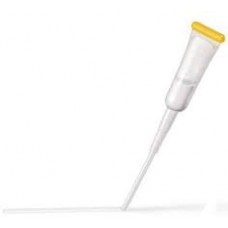HISTOACRYL CLEAR, PACK/10 (BB1050071)
- Brand: B|Braun
- Product Code: BB1050071
-
Ex GST: AU$249.99
HISTOACRYL CLEAR 10's
Features:
- Local anaesthetic not required
- No removal of sutures
- Protected against infection
- Wound closure in one minute
- Storage at room temperature
General Information:
Histoacryl® and Histoacryl® Blue are sterile, liquid topical skin adhesives composed of n-Butyl-2-Cyanoacrylate monomer. The two products are different in only one respect: Histoacryl® is provided as a colorless liquid, and Histoacryl® Blue is colored with the dye D&C Violet #2 in order to make it easier to see the thickness of the layer of Histoacryl® Blue being applied. Histoacryl® and Histoacryl® Blue topical skin adhesives are supplied in a 0.5 ml single patient use plastic ampoules. Each ampoule is sealed within a foil pouch so the exterior of the ampoule can remain sterile. Histoacryl® remains liquid until exposed to acidic, basic, alcohol, water or watercontaining substances, including tissues. Histoacryl® cures (polymerizes exothermically) and forms a film that bonds to the underlying surface. All references to Histoacryl® herein refer to both Histoacryl® (without dye) and Histoacryl® Blue (with dye) unless stated otherwise.
Indication:
Histoacryl® and Histoacryl® Blue topical skin adhesives are intended for topical application to hold closed easily approximated skin edges of minimum-tension wounds from clean surgical incisions and simple, thoroughly cleansed, trauma-induced lacerations. Histoacryl® and Histoacryl® Blue may be used in conjunction with, but not in place of, dermal sutures.
Contraindication:
• Histoacryl® topical skin adhesive is not to be applied below the surface of the skin. The liquid adhesive will react exothermically with tissue; the polymerized adhesive is not absorbed by any tissues and may elicit a foreign body reaction.
• Histoacryl® is not to be applied to any internal organs, blood vessels, nerve tissue, mucosal surfaces or mucocutaneous junctions, areas with dense natural hair, or within the conjunctival sac of the eye.
• Histoacryl® is not to be applied to the surface of the eye. If the eyelids are accidentally bonded closed, release eyelashes with warm water by covering with a wet pad. The adhesive will bond to eye protein and will cause periods of weeping which will help to debond the adhesive. Keep the eye covered until debonding is complete – usually within 1 to 3 days. Do not force the eye open.
• Histoacryl® is not to be applied to wounds subject to high skin tension, or on areas of increased skin tension such as the elbows, knees, or knuckles. Histoacryl® is not to be used in areas of skin excision.
• Histoacryl® is not to be applied to wounds that show evidence of infection, gangrene or wounds of decubitus etiology.
• Histoacryl® is not to be used on patients with known preoperative systemic infections, uncontrolled diabetes, or diseases or conditions that are known to interfere with the wound healing process.
• Histoacryl® is not to be used on patients with a known hypersensitivity to cyanoacrylate, formaldehyde, or the dye D&C Violet #2.
Warnings:
• Histoacryl® topical skin adhesive should be used only on wounds that have been thoroughly cleaned, debrided and have easily apposed wound edges.
• Histoacryl® generates a small amount of heat during polymerization and should not be applied to tissues that may be affected by such heat.
• Histoacryl® should always be applied very sparingly, either as minute drops or as a very thin film along the edges of the wound. Heavy application may cause thermal damage to tissues, and delayed healing may result.
• Histoacryl® should not be applied to wet wounds. Excess moisture, such as water or alcohol, may accelerate polymerization, resulting in the generation of excess heat.
• Use of Histoacryl® may result in localized sensitization or irritation reactions.
• Application and/or migration (leak) of either version of the product below the surface of the skin will impair the healing process by forming a barrier between tissue edges.
• Histoacryl® Blue migration (leak) below the epidermal surface may result in “tattooing” of the underlying tissue.
• Histoacryl® will readily adhere to most substrates. Care should be taken to avoid unwanted contact with the adhesive during polymerization. Polymerized adhesive can be removed from metal instruments with acetone. Accidental bonding of materials other than tissues may be reversed by peeling apart the adhered surfaces with the aid of warm soapy water, petroleum gel, saline solution, or 5% solution of sodium bicarbonate.
• Accidental bonding of unwanted skin may occur. Do not pull apart skin. Instead, accidental bonding of unintended areas of skin of the body can be corrected with the use of acetone or by soaking in warm water until the skin may be separated.
Precautions:
• Wounds should be kept dry following closure with Histoacryl®. Do not apply topical medications followingclosure.
• In the event of spillage, Histoacryl® can be absorbed with talc. Flush area with water to solidify the adhesive.
• Histoacryl® has not been evaluated in patients with a history of hypertrophic scarring or keloid information.
• Small quantities of Histoacryl® should be used during wound repair because use of excess Histoacryl® can result in tissue damage due to the cumulative heat dissipated during device polymerization.
Tags: Skin Closure, Tissue Adhesive, Wound Care

